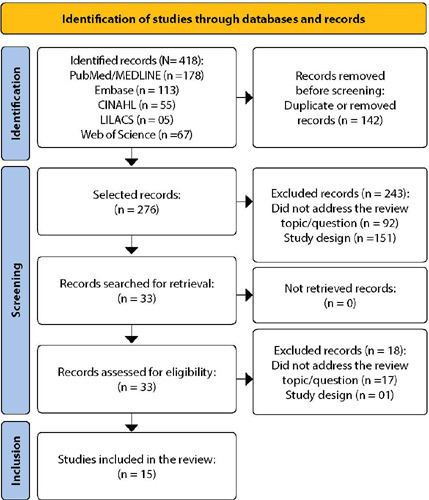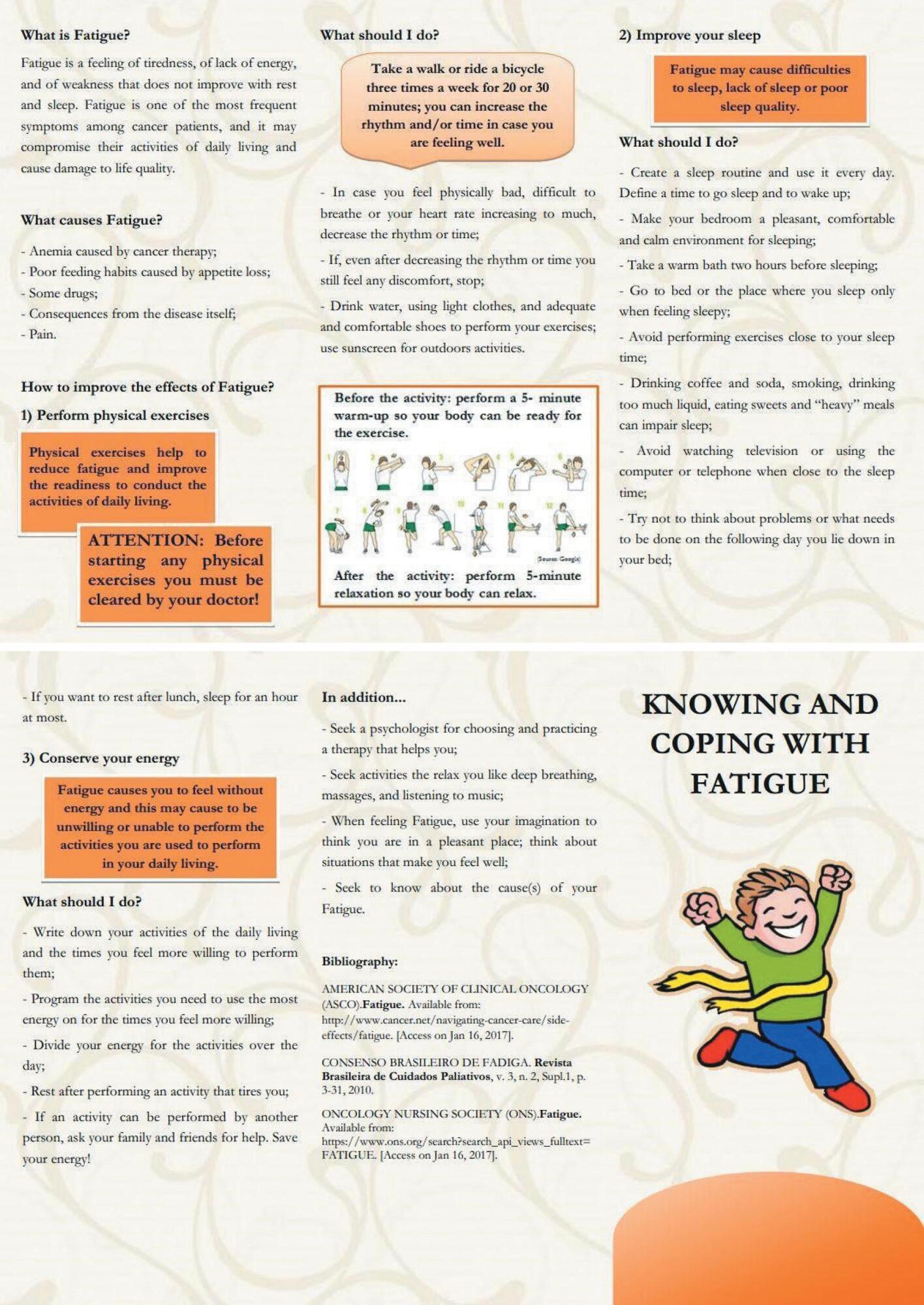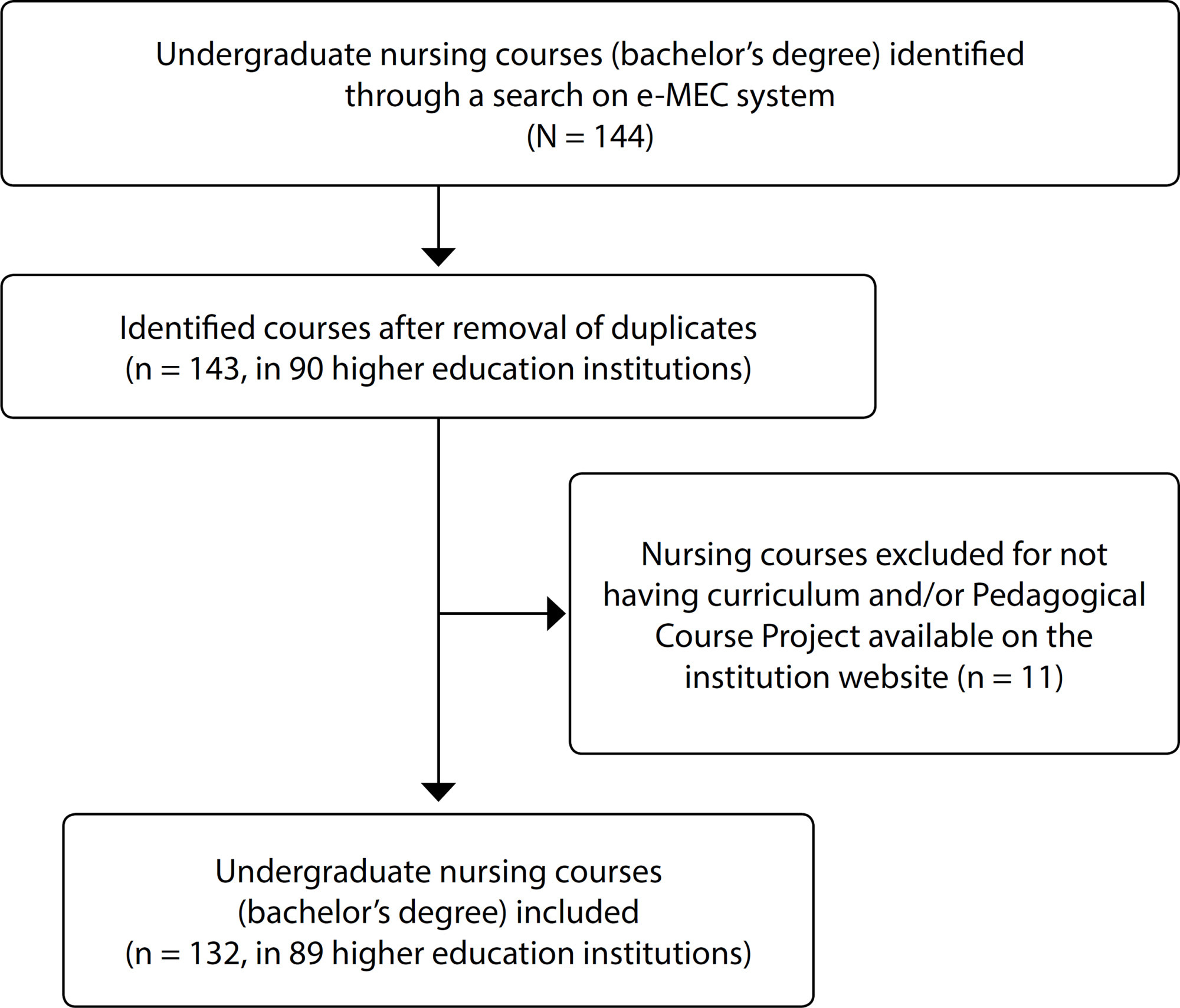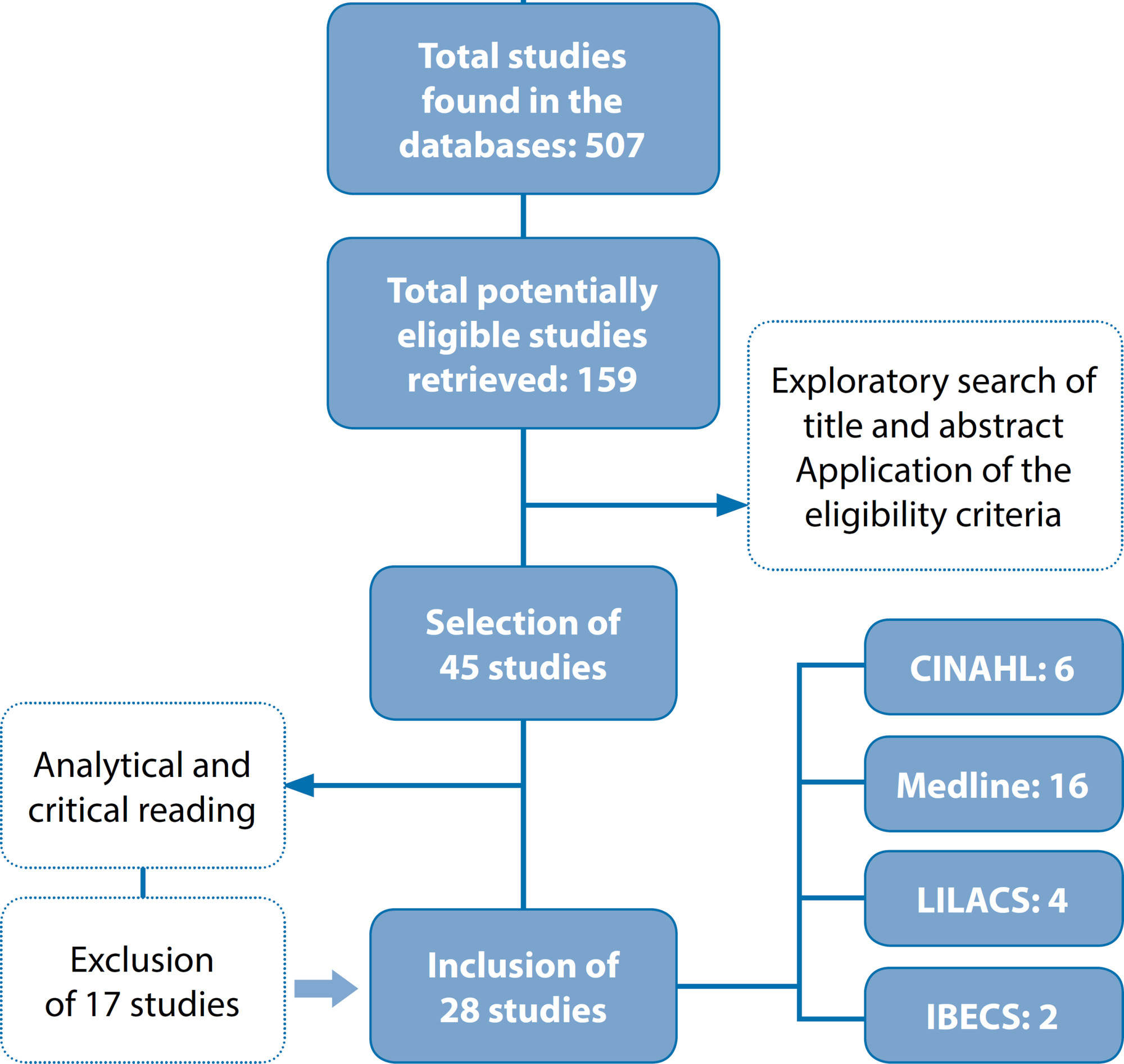-
ORIGINAL ARTICLE08-07-2023
Factors associated with the time to treat breast cancer in the pandemic period: an observational study
Revista Brasileira de Enfermagem. 2023;76:e20220428
Abstract
ORIGINAL ARTICLEFactors associated with the time to treat breast cancer in the pandemic period: an observational study
Revista Brasileira de Enfermagem. 2023;76:e20220428
DOI 10.1590/0034-7167-2022-0428
Views0See moreABSTRACT
Objectives:
to analyze the factors associated with the time to surgical treatment for breast cancer in patients seen at a reference mastology outpatient clinic in the State of Ceará.
Methods:
analytical, longitudinal study with medical charts from the Mastology Outpatient Clinic of Assis Chateaubriand Maternity School. We used 140 medical charts of breast cancer patients with surgeries performed during the pandemic.
Results:
the study evidenced associations between schooling and shorter time to treatment in patients who underwent biopsy before the first outpatient visit (p = 0.026; OR: 0.16; CI = 0.03-0.85); in the group who had the biopsy performed by the outpatient clinic, was associated the type of tumor (p = 0.019) and neoadjuvant therapy (p = 0.000).
Conclusions:
the lesser educational level, tumor type, and use of neoadjuvant therapy were factors associated with the time to treatment during the pandemic period.
-
ORIGINAL ARTICLE08-07-2023
Nursing students’ knowledge and attitude in relation to COVID-19 prevention behavior
Revista Brasileira de Enfermagem. 2023;76:e20220588
Abstract
ORIGINAL ARTICLENursing students’ knowledge and attitude in relation to COVID-19 prevention behavior
Revista Brasileira de Enfermagem. 2023;76:e20220588
DOI 10.1590/0034-7167-2022-0588
Views0See moreABSTRACT
Objectives:
to determine the correlation between nursing students’ level of knowledge and attitudes toward COVID-19 prevention behavior.
Methods:
a cross-sectional study was carried out at the Private University in Indonesia. Accidental sampling was used to select 188 third-year bachelor’s nursing students as respondents. Data collection was conducted through an online questionnaire (Cronbach’s Alpha 0.799-0.959) consisting of 27 questions. The data were analyzed descriptively and inferentially.
Results:
as many as 49.5 % of respondents had high knowledge, 98.4 % had a positive attitude, and 89.9 % had positive behavior in preventing COVID-19 transmission. The Chi-square test revealed that knowledge has no correlation with COVID-19 prevention behavior (p-value 0.864), but attitude did (p-value 0.027).
Conclusions:
nursing students’ attitudes are related to behavior in preventing COVID-19. Nursing students are expected to maintain positive attitudes and behaviors toward COVID-19 prevention as future health workers at the forefront of health services.
-
08-07-2023
Conhecimento e atitude dos estudantes de enfermagem em relação ao comportamento de prevenção à COVID-19
Revista Brasileira de Enfermagem. 2023;76:e20220588
Abstract
Conhecimento e atitude dos estudantes de enfermagem em relação ao comportamento de prevenção à COVID-19
Revista Brasileira de Enfermagem. 2023;76:e20220588
DOI 10.1590/0034-7167-2022-0588
Views0See moreRESUMEN
Objetivos:
determinar la correlación entre el nivel de conocimiento y las actitudes de los estudiantes de enfermería en relación a la conducta de prevención de la COVID-19.
Métodos:
estudio transversal realizado en una Universidad Privada de Indonesia. Se utilizó un muestreo accidental para seleccionar a 188 estudiantes de tercer año de enfermería como encuestados. La recolección de datos se realizó mediante un cuestionario en línea que consta de 27 preguntas (alfa de Cronbach 0.799-0.959). Los datos fueron analizados de forma descriptiva e inferencial.
Resultados:
el 49,5 % de los encuestados tenía conocimientos altos, el 98,4 % tenía una actitud positiva y el 89,9 % tenía un comportamiento positivo en la prevención de la transmisión de la COVID-19. La prueba de Chi-cuadrado reveló que el conocimiento no tiene correlación con el comportamiento de prevención de COVID-19 (valor de p 0,864), pero la actitud sí (valor de p 0,027).
Conclusiones:
las actitudes de los estudiantes de enfermería están relacionadas con el comportamiento en la prevención del COVID-19. Se espera que los estudiantes de enfermería mantengan actitudes y comportamientos positivos hacia la prevención de COVID-19 como futuros profesionales de la salud en la primera línea de los servicios de salud.
-
08-07-2023
Senso de coerência e apoio social como preditores de saúde mental durante a pandemia de COVID-19
Revista Brasileira de Enfermagem. 2023;76:e20220468
Abstract
Senso de coerência e apoio social como preditores de saúde mental durante a pandemia de COVID-19
Revista Brasileira de Enfermagem. 2023;76:e20220468
DOI 10.1590/0034-7167-2022-0468
Views0See moreRESUMEN
Objetivos:
verificar el papel del sentido de coherencia, sentido de coherencia nacional, apoyo social y confianza en las instituciones como predictores de salud mental en brasileños durante la pandemia de COVID-19.
Métodos:
estudio transversal, realizado de noviembre de 2020 a enero de 2021 mediante cuestionario online. Se utilizaron instrumentos estandarizados. La muestra estuvo compuesta por 1.630 brasileños. En el análisis de datos se realizaron correlación de Pearson y regresión lineal.
Resultados:
el sentido de coherencia fue el único predictor de ansiedad [β= -0,61;p<0,001], explicando el 38% de la variación de sus puntuaciones, mientras que el sentido de coherencia [β=0,52;p<0,001], sentido de coherencia nacional [β= 0,16;p<0,001] y apoyo social [β=0,15;p<0,001] fueron predictores de salud mental positiva y en conjunto explicaron el 51% de su variación.
Conclusiones:
los hallazgos sugieren que sentido de coherencia, sentido de coherencia nacional y el apoyo social representan importantes predictores de salud mental y que el fortalecimiento de estos recursos, podría potencialmente promover la salud mental de los brasileños.
-
ORIGINAL ARTICLE08-07-2023
Sense of coherence and social support as predictors of mental health during COVID-19 pandemic
Revista Brasileira de Enfermagem. 2023;76:e20220468
Abstract
ORIGINAL ARTICLESense of coherence and social support as predictors of mental health during COVID-19 pandemic
Revista Brasileira de Enfermagem. 2023;76:e20220468
DOI 10.1590/0034-7167-2022-0468
Views0See moreABSTRACT
Objectives:
to verify the role of sense of coherence, sense of national coherence, social support and trust in institutions to predict mental health in Brazilians during the COVID-19 pandemic.
Methods:
a cross-sectional study, carried out from November, 2020 to January, 2021 via an online survey. Standardized instruments were used. The sample consisted of 1,630 Brazilians. Pearson’s correlation and linear regression were performed in data analysis.
Results:
sense of coherence was the only predictor of anxiety [β= -0.61; p<0.001], explaining 38% of the variance in its scores, while sense of coherence [β= 0.52; p<0.001], sense of national coherence [β= 0.16; p<0.001], and social support [β= 0.15; p<0.001] predicted positive mental health and together explained 51% of its variance.
Conclusions:
the findings suggest that sense of coherence, sense of national coherence and social support represent important predictors for mental health and that strengthening these resources, could potentially promote Brazilians’ mental health.
-
ORIGINAL ARTICLE07-31-2023
Primary Health Care assessment in the COVID-19 pandemic from physicians’ and nurses’ perspective
Revista Brasileira de Enfermagem. 2023;76:e20220475
Abstract
ORIGINAL ARTICLEPrimary Health Care assessment in the COVID-19 pandemic from physicians’ and nurses’ perspective
Revista Brasileira de Enfermagem. 2023;76:e20220475
DOI 10.1590/0034-7167-2022-0475
Views0See moreABSTRACT
Objectives:
to assess the operationalization of Primary Health Care in the COVID-19 pandemic, according to Primary Care Assessment Tool: PCATool-Brasil attributes, from physicians’ and nurses’ perspective.
Methods:
a cross-sectional study, carried out with 99 physicians and nurses from Basic Health Units in a state in northeastern Brazil, with the aid of the adapted instrument PCATool-Brasil.
Results:
Essential Score was classified as high performance (6.6) and General Score as low performance (6.5). First Contact Access, Care Integration, and Community Guidance scores were <6.6. The best performances were attributed to the Longitudinality, Comprehensiveness and Family Guidance services (scores>6.6).
Conclusions:
the attributes of Primary Health Care, in general, showed values above or close to the cut-off point in the assessment. These data can support strategies for local and national managers to strengthen Primary Health Care in the COVID-19 pandemic and future public health emergencies.
-
07-31-2023
Breastfeeding prevalence in newborns of mothers with COVID-19: a systematic review
Revista Brasileira de Enfermagem. 2023;76:e20220173
Abstract
Breastfeeding prevalence in newborns of mothers with COVID-19: a systematic review
Revista Brasileira de Enfermagem. 2023;76:e20220173
DOI 10.1590/0034-7167-2022-0173
Views0See moreABSTRACT
Objectives:
to compare exclusive breastfeeding prevalence versus artificial feeding in newborns of mothers with COVID-19.
Methods:
a systematic review of prevalence, according to JBI. Searches in PubMed®, Embase, CINAHL, LILACS and Web of Science™ databases in August 2021. Cross-sectional, longitudinal or cohort studies were selected, without language and time limitations that showed breastfeeding prevalence or that allowed calculation.
Results:
fifteen articles published in 2020 and 2021, cohort (60%) or cross-sectional (40%) were analyzed. The average of exclusive breastfeeding in mothers with COVID-19 was 56.76% (CI=39.90–72.88), and artificial breastfeeding, 43.23% (CI = 30.99 – 55.88), without statistically significant differences.
Conclusions:
despite the recommendations for maintaining breastfeeding, there was a reduction worldwide, when compared to periods prior to the pandemic. With advances in science, these rates have improved, showing the impact of evidence on practices. As limitations, study sources are cited. It is recommended to carry out new studies. PROSPERO registration CRD42021234486.

-
ORIGINAL ARTICLE07-31-2023
Sociodemographic profile, diagnoses and nursing care in post-COVID-19 patients in a Brazilian university hospital
Revista Brasileira de Enfermagem. 2023;76:e20220730
Abstract
ORIGINAL ARTICLESociodemographic profile, diagnoses and nursing care in post-COVID-19 patients in a Brazilian university hospital
Revista Brasileira de Enfermagem. 2023;76:e20220730
DOI 10.1590/0034-7167-2022-0730
Views0See moreABSTRACT
Objectives:
to analyze the sociodemographic profile, diagnoses and nursing care of post-COVID-19 patients admitted to a university hospital in southern Brazil.
Methods:
a retrospective cohort study. The sample consisted of 1,467 medical records, from January 2020 to January 2021.
Results:
from the analyzed medical records, the most prevalent profiles, respectively, included: males (52.9%); white (81.1%); with Impaired Physiological Balance Syndrome* Nursing Diagnosis (77.3%); nursing care implementing aerosol precautions (94.5%); implementing droplet precautions (93.4%); checking vital signs (91.9%); applying standard disinfectant to equipment and surfaces (89.6%).
Conclusions:
the analysis of the sociodemographic profile, diagnoses and nursing care of patients in this study may contribute to implementing the Nursing Process in the coronavirus pandemic context.

-
ORIGINAL ARTICLE10-21-2019
Work overload and risk behaviors in motorcyclists
Revista Brasileira de Enfermagem. 2019;72(6):1479-1484
Abstract
ORIGINAL ARTICLEWork overload and risk behaviors in motorcyclists
Revista Brasileira de Enfermagem. 2019;72(6):1479-1484
DOI 10.1590/0034-7167-2018-0279
Views0See moreABSTRACT
Objective:
to analyze the association between work overload and risk behaviors adopted by motorcyclists.
Method:
a cross-sectional study of injured motorcycle drivers hospitalized at the Hospital da Restauração Governador Paulo Guerra in the city of Recife, PE, from May to September 2016. A questionnaire was applied containing sociodemographic variables related to work overload and risk behaviors adoption. Odds Ratio (OR) and 95% Confidence Interval were used to analyze the association between the variables.
Results:
there was a predominance of males (97.6%), mean age 31.44 years (SD = 9.50). There was an association of sleep/fatigue at the accident time with difficulties carrying out work tasks (OR = 3.7), feeling tired during work (OR = 4.6) and feeling under pressure to carry out work tasks (OR = 3.5).
Conclusion:
work overload was associated with risk behaviors adoption. It is believed that this fact can have an impact on the occurrence and severity of accidents.
-
ORIGINAL ARTICLE10-21-2019
Educational technology for fatigue management related to antineoplastic chemotherapy
Revista Brasileira de Enfermagem. 2019;72(6):1519-1525
Abstract
ORIGINAL ARTICLEEducational technology for fatigue management related to antineoplastic chemotherapy
Revista Brasileira de Enfermagem. 2019;72(6):1519-1525
DOI 10.1590/0034-7167-2018-0505
Views0See moreABSTRACT
Objective:
To construct and validate an educational technology (ET) on fatigue and non-pharmacological strategies for the management of this symptom in people with cancer undergoing outpatient antineoplastic chemotherapy.
Method:
This is a methodological study composed of three stages: 1) elaboration of the ET using the theoretical-methodological model of Doak, Doak and Root; 2) validation of content and appearance by seven nurses via the content validity index (CVI); and 3) a pilot test with 10 patients.
Results:
The ET “Knowing and coping with fatigue” contemplates the definition of fatigue, its causes and the interventions of physical exercise practice, sleep hygiene, energy conservation and behavioral intervention. The overall CVI obtained with the judges was 0.95.
Conclusion:
The ET presented content and appearance validity for health education regarding fatigue related to antineoplastic chemotherapy in outpatient cancer patients.

-
ORIGINAL ARTICLE10-01-2022
Continuity of care for children with special healthcare needs during the COVID-19 pandemic
Revista Brasileira de Enfermagem. 2022;75(2):e20210150
Abstract
ORIGINAL ARTICLEContinuity of care for children with special healthcare needs during the COVID-19 pandemic
Revista Brasileira de Enfermagem. 2022;75(2):e20210150
DOI 10.1590/0034-7167-2021-0150
Views0See moreABSTRACT
Objective:
To describe the continuity of care for children with special healthcare needs during the COVID-19 pandemic through the perception of their caregivers in the Northeast of Brazil.
Methods:
Qualitative descriptive-exploratory research carried out between June and September 2020, in a municipality in the Northeast of Brazil. Eleven caregivers participated through semi-structured interviews conducted at home. The data were submitted to thematic content analysis.
Results:
The social isolation period and the suspension of health services affected the continuity of care, configuring the category “Implications of the COVID-19 pandemic for the continuity of care”. Caregivers expressed fear of children contracting the coronavirus, characterizing the category “Fears and uncertainties of the COVID-19 pandemic in view of the vulnerability of children with special healthcare needs”.
Final considerations:
Caregivers’ reports revealed problems in the continuity of care for the studied cohort. Therefore, health care practices must be rethought in times of pandemic.
-
ORIGINAL ARTICLE01-14-2022
Knowledge, attitudes and practices related to sexually transmitted infections of men in prison
Revista Brasileira de Enfermagem. 2022;75:e20201273
Abstract
ORIGINAL ARTICLEKnowledge, attitudes and practices related to sexually transmitted infections of men in prison
Revista Brasileira de Enfermagem. 2022;75:e20201273
DOI 10.1590/0034-7167-2020-1273
Views0See moreABSTRACT
Objectives:
to analyze the knowledge, attitudes, and practices related to sexually transmitted infections of men in prison.
Methods:
qualitative study, based on the methodology Knowledge, Attitude and Practice, conducted with 30 men in prison. The study applied individual interviews submitted to the analyze of the discourse.
Results:
the incipient knowledge of men was associated with: self-illness and the others’, diagnosis, and perception of risk behavior, pervaded by distrust or lack of understanding of the rapid test for detection. The attitudes involved culpability of partnerships, non-adherence to prevention inputs, and resistance to look for health services. The practices are linked to health care after the identification of the disease, use of penile condoms, and attention to the partnership.
Conclusions:
the reduced knowledge about Sexually Transmitted Infections makes attitudes stereotyped, stigmatized, compromised by the level of education. The level of health care and the limits of deprivation of liberty weaken the practices.
-
ORIGINAL ARTICLE12-13-2019
Nurses’ experiences in the care of high-risk newborns: a phenomenological study
Revista Brasileira de Enfermagem. 2019;72:111-117
Abstract
ORIGINAL ARTICLENurses’ experiences in the care of high-risk newborns: a phenomenological study
Revista Brasileira de Enfermagem. 2019;72:111-117
DOI 10.1590/0034-7167-2018-0221
Views0See moreABSTRACT
Objective:
To describe nurses’ experience in the care of high-risk newborns.
Method:
This is a descriptive study with a qualitative approach, based on Merleau-Ponty’s phenomenology and performed at the Fernando Magalhães Maternity Hospital in the state of Rio de Janeiro, through interviews with 30 nurses who work in neonatal care, according to the phenomenological thinking of Maurice Merleau- Ponty.
Results:
Three categories emerged: “experienced body of the nurse practitioner on the high-risk newborn”; “experienced world of the nurse practitioner on the high-risk newborn”; and “time spent by the nurse practitioner with the high-risk newborn”.
Final considerations:
The study allowed us to describe, through the participants’ speeches, that the care of the high-risk newborn is broad, that is, objective, subjective and carried out with advanced technologies, their experiences and scientific improvement are composed of shared practice and theory with the family, professionals and beginners in the neonatal universe, favoring a differentiated and humanized care.
-
ORIGINAL ARTICLE05-21-2021
Oncology teaching in undergraduate nursing at public institutions courses in Brazil
Revista Brasileira de Enfermagem. 2021;74(2):e20200851
Abstract
ORIGINAL ARTICLEOncology teaching in undergraduate nursing at public institutions courses in Brazil
Revista Brasileira de Enfermagem. 2021;74(2):e20200851
DOI 10.1590/0034-7167-2020-0851
Views0See moreABSTRACT
Objectives:
to identify the occurrence of oncology teaching in undergraduate nursing curricula.
Methods:
descriptive study, which data was obtained from curriculum and from Pedagogical Course Projects available on the websites from Brazilian public institutions, between June and July 2020.
Results:
143 undergraduate nursing courses were identified. From them, 132 nursing courses (corresponding to 89 education institutions) had available the curriculum and/or Pedagogical Course Projects. Only 7 (5.3%) of them had oncology as a mandatory subject, 4 of them in the Midwest Region. Only 35 (26.5%) had elective subject in Oncology, most of them in the Northeast (45.7%).
Conclusions:
on third of nursing courses at public institutions has Oncology subject in the curriculum, which is few considering the high incidence and mortality from cancer in the country. The findings contribute for discussions, in curricular accommodation, on the relevance of oncology teaching in nursing curricula.

-
ORIGINAL ARTICLE12-13-2019
Early stimulation in the development of children with microcephaly: maternal perception
Revista Brasileira de Enfermagem. 2019;72:139-146
Abstract
ORIGINAL ARTICLEEarly stimulation in the development of children with microcephaly: maternal perception
Revista Brasileira de Enfermagem. 2019;72:139-146
DOI 10.1590/0034-7167-2018-0272
Views0See moreABSTRACT
Objective:
To know the maternal perception about early stimulation and its repercussion in the development of the child with microcephaly associated with zika virus.
Method:
A qualitative study was carried out from June to August 2017 with five mothers of children diagnosed with microcephaly associated with zika virus. The data were collected through individual interviews with semi-structured script and evaluated by the content analysis, in its thematic modality.
Results:
Mothers recognized the benefits and the advances in the development of the child after the beginning of the early stimulation. It is noteworthy that the difficulty of transportation was the main reason for the lack of attendance at consultations, and that the short time of stimulation was the main weakness of the service.
Final considerations:
The recognition of maternal perception and the difficulties and weaknesses of the service can contribute to the elaboration of public policies and the planning of holistic care for children with microcephaly and their families.
-
REVIEW06-18-2021
Microbiological profile of leg ulcer infections: review study
Revista Brasileira de Enfermagem. 2021;74(3):e20190763
Abstract
REVIEWMicrobiological profile of leg ulcer infections: review study
Revista Brasileira de Enfermagem. 2021;74(3):e20190763
DOI 10.1590/0034-7167-2019-0763
Views0See moreABSTRACT
Objectives:
to analyze the microbiological profile of leg ulcers of patients treated at outpatient clinics and hospitals regarding the type of microorganism, microbiological selection of antibiotics, and techniques for the collection of culture material.
Methods:
literature review performed on LILACS, IBECS, MEDLINE, and CINAHL databases, resulting in a descriptive analysis of 27 studies.
Results:
35.7% of the studies occurred in an outpatient care scenario; and 64.2% in hospitals. There was a predominance of swab (100%) in outpatient care and biopsy (55.5%) in the hospital. Escherichia coli, Pseudomonas aeruginosa, and Staphylococcus aureus were more common at both levels of assistance. Methicillin-resistant Staphylococcus aureus was isolated in both.
Conclusions:
the microbiological profile of infections was similar, with the presence of resistant bacteria in both environments. This fact causes concern and raises the need for research to elucidate it. The studies did not compare the effectiveness between biopsy and swab.

Search
Search in:
Nuvem de Tags
Adolescente (85) Atenção Primária à Saúde (239) COVID-19 (91) Criança (91) Cuidados de Enfermagem (269) Educação em Enfermagem (151) Educação em Saúde (139) Enfermagem (930) Enfermagem Pediátrica (86) Estudantes de Enfermagem (77) Estudos de Validação (131) Família (87) Idoso (208) Promoção da Saúde (99) Qualidade de Vida (104) Saúde do Trabalhador (86) Saúde Mental (145) Saúde Pública (82) Segurança do Paciente (150) Tecnologia Educacional (100)



